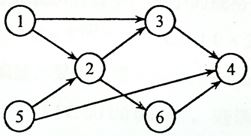Write a program to test if a give sequence Seq is a topological order of a given graph Graph.
Format of functions:
bool IsTopSeq( LGraph Graph, Vertex Seq[] );
where LGraph is defined as the following:
typedef struct AdjVNode *PtrToAdjVNode;
struct AdjVNode{
Vertex AdjV;
PtrToAdjVNode Next;
};
typedef struct Vnode{
PtrToAdjVNode FirstEdge;
} AdjList[MaxVertexNum];
typedef struct GNode *PtrToGNode;
struct GNode{
int Nv;
int Ne;
AdjList G;
};
typedef PtrToGNode LGraph;
The function IsTopSeq must return true if Seq does correspond to a topological order; otherwise return false.
Note: Although the vertices are numbered from 1 to MaxVertexNum, they are indexed from 0 in the LGraph structure.
Sample program of judge:
#include <stdio.h>
#include <stdlib.h>
typedef enum {false, true} bool;
#define MaxVertexNum 10 /* maximum number of vertices */
typedef int Vertex; /* vertices are numbered from 1 to MaxVertexNum */
typedef struct AdjVNode *PtrToAdjVNode;
struct AdjVNode{
Vertex AdjV;
PtrToAdjVNode Next;
};
typedef struct Vnode{
PtrToAdjVNode FirstEdge;
} AdjList[MaxVertexNum];
typedef struct GNode *PtrToGNode;
struct GNode{
int Nv;
int Ne;
AdjList G;
};
typedef PtrToGNode LGraph;
LGraph ReadG(); /* details omitted */
bool IsTopSeq( LGraph Graph, Vertex Seq[] );
int main()
{
int i, j, N;
Vertex Seq[MaxVertexNum];
LGraph G = ReadG();
scanf("%d", &N);
for (i=0; i<N; i++) {
for (j=0; j<G->Nv; j++)
scanf("%d", &Seq[j]);
if ( IsTopSeq(G, Seq)==true ) printf("yes
");
else printf("no
");
}
return 0;
}
/* Your function will be put here */
Sample Input (for the graph shown in the figure):
6 8
1 2
1 3
5 2
5 4
2 3
2 6
3 4
6 4
5
1 5 2 3 6 4
5 1 2 6 3 4
5 1 2 3 6 4
5 2 1 6 3 4
1 2 3 4 5 6
Sample Output:
yes
yes
yes
no
no
题目的大致意思就是,给你一组数据,根据这组数据构建一个有向图,再给你几组序列,判断是不是拓扑序列。
思路:先确定每个结点的入度数,按拓扑顺序输出结点时,每输出一个结点,将其子结点的入度数 -1.
注意:输入的顶点是从 0 开始存放的,也就是
| 0 | 1 | 2 | 3 | 4 |
| G1 | G2 | G3 | G4 | G5 |
struct AdjVNode{ Vertex AdjV; PtrToAdjVNode Next; };
中的 AdjV,也是从 0 开始存放。
代码:
bool IsTopSeq( LGraph Graph, Vertex Seq[] ){
int inDegree[1000];
for(int i=0;i<=Graph->Nv;i++)
inDegree[i]=0;
PtrToAdjVNode temnode;
for(int i=0;i<Graph->Nv;i++){
temnode=Graph->G[i].FirstEdge;
while (temnode){
inDegree[temnode->AdjV]++;
temnode=temnode->Next;
}
}
for(int i=0;i<Graph->Nv;i++){
if(inDegree[Seq[i]-1]!=0)
return false;
else{
temnode=Graph->G[Seq[i]-1].FirstEdge;
while(temnode){
inDegree[temnode->AdjV]--;
temnode=temnode->Next;
}
}
}
return true;
}
